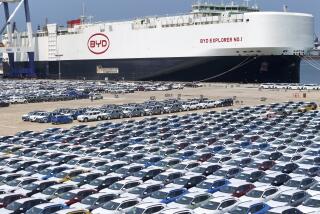Shifting Attitudes : With sales slowing, foreign car makers are offering more rebates--and boosting their market share.
- Share via
Once upon a time, foreign car makers scoffed at sales incentives--rebates and the like--that were the hallmark of their domestic rivals. Instead, they opted to hawk a car solely on its merit.
But, with sales cooling and competition heating up, that attitude has changed dramatically.
With increasing regularity, importers from around the world have been sweetening the pots for their dealers and customers, slashing financing costs and doling out cash rebates with the Big Three.
“It’s just a reflection of the competitive nature of the marketplace,” said Bob Butorac, a Honda spokesman. “We are definitely seeing more incentive programs these days.”
For instance, as part of Honda’s first incentive package, dealers who reached their sales objectives were awarded $100 for each car sold between April 1 and May 31. Dealers received an extra $200 for each car sold if they hit a certain sales target for the first month of the program and surpassed their two-month sales goal by 15%.
Toyota dealers who meet their sales goals can receive up to $1,000 for each car sold under an incentive program designed to commemorate the first anniversary of the production of the Camry at the company’s Kentucky plant. The program expires July 3.
Mazda designed an incentive plan that, before it expired at the end of last month, offered $400 cash-to-customer rebates on the company’s 323 models.
Among the numerous incentive packages offered by Nissan, one refunds customers $1,000 on all 1989 Sentra wagons and coupes purchased between May 3 and July 5. Another plan, for 1989 Stanzas, offers customers either $1,500 cash or financing that ranges from 7.9% for 48 months to 9.9% for 60 months.
“We’ve had an incentive program off and on for 18 months,” said Bill Pauli, a spokesman for Nissan. “We are just responding to changes in the industry.”
‘Cool Down in Sales’
The increase in import incentives started about two years ago but has picked up noticeably since January. Analysts say the rise has been sparked by a cyclical downturn in the industry and an overcrowded market.
“The lower end of the market, the Japanese end, is experiencing a cool down in sales,” said Scott Merlis, an analyst at Morgan Stanley. “The reason the Europeans have offered more incentives is because European products have been more pricey.”
Among Japanese auto makers, sales of Hondas dropped by 6.3% in the first quarter while Mazda’s sales in the first four months of 1989 slid 13% to 72,824 from 83,933 in 1988.
Mercedes-Benz sales also declined, from 27,643 during the first four months of 1988 to 23,376 in this year’s first quarter.
Such losses, coupled with continuous waves of incentive packages from U.S. car makers, have compelled the importers to do more to lure buyers.
And although U.S. auto companies have offered incentives since the early 1950s, analysts say the new crop of sales programs benefit imports more. This is partially because many consumers already view them as better cars and, thus, better buys.
“Before, domestic manufacturers owned the game, but now the Japanese have found it,” said Christopher Cedergren, an analyst at J. D. Power & Associates. “The incentive strategy is working extremely well for the Japanese. It has helped increase their market share by a full 3%.”
‘Incentives Really Working’
Cedergren noted that the Japanese share of the market rests at 24.3%.
“It has never been this high,” he said. “They didn’t use the incentives before, because they didn’t need to. But now that they have, the incentives are really working.”
He said the Germans were also competing in the incentives battle, albeit more inconspicuously.
“The Germans’ programs have been more camouflaged,” said Cedergren. “Their plans have been more heavily involving leasing programs. There has also been some cash-backs to dealers.”
He attributed the companies’ low-key approach to the unfavorable light in which incentive plans tend to cast cars and their manufacturers.
“Incentives have the connotation of a fire sale,” Cedergren said. “That gives a negative image to the car and hurts the image of the company. A fire-sale approach can really hurt a luxury car, because, although people go in looking for a deal, they also want people to think they paid top dollar for their Mercedes.”
However, he said, the potential damage of the current marketing gambits has been offset by their increasing number.
Nonetheless, some importers say they are not willing to go as far as the domestic car makers to lure customers.
“We don’t offer any customer incentives,” said Debra Sanchez, a Toyota spokesperson. “We find that the best way to offer incentives is to dealers. We feel they know what to do with it.”
Still, Cedergren says, despite the label placed on the programs, incentive packages are all designed for one purpose: to attract buyers.
“The bottom line,” he said, is that an “incentive is an incentive is an incentive.”






